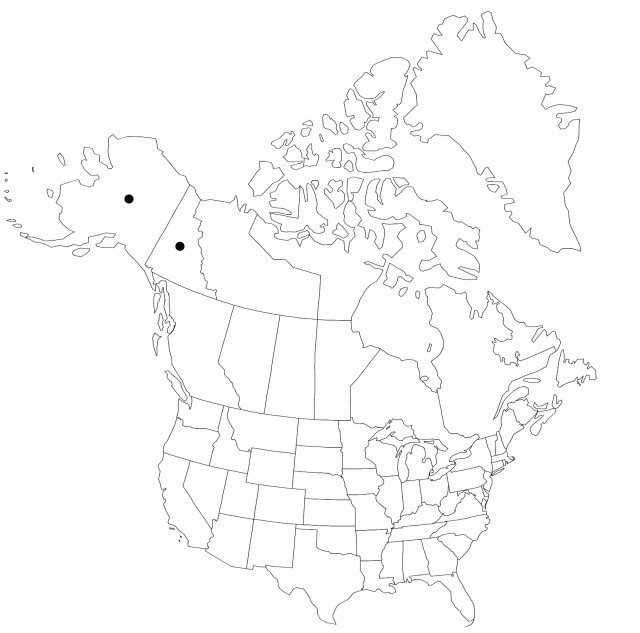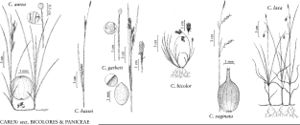Difference between revisions of "Carex laxa"
Kongl. Vetensk. Acad. Nya Handl. 24: 162. 1803.
FNA>Volume Importer |
imported>Volume Importer |
||
| (6 intermediate revisions by 2 users not shown) | |||
| Line 23: | Line 23: | ||
|elevation=900–1100 m | |elevation=900–1100 m | ||
|distribution=Yukon;Alaska;Eurasia. | |distribution=Yukon;Alaska;Eurasia. | ||
| − | |discussion=<p>Carex laxa superficially resembles C. limosa in size and habit; it is easily distinguished by its sheathing proximal inflorescence bracts, by its rhizomatous habit, and by its roots lacking a dense covering of root hairs. Carex limosa has sheathless inflorescence bracts, is stoloniferous, and has roots densely covered with yellowish orange root hairs. Carex laxa may well be overlooked in the north, being mistaken in the field for the more common C. limosa.</p> | + | |discussion=<p><i>Carex laxa</i> superficially resembles <i>C. limosa</i> in size and habit; it is easily distinguished by its sheathing proximal inflorescence bracts, by its rhizomatous habit, and by its roots lacking a dense covering of root hairs. <i>Carex limosa</i> has sheathless inflorescence bracts, is stoloniferous, and has roots densely covered with yellowish orange root hairs. <i>Carex laxa</i> may well be overlooked in the north, being mistaken in the field for the more common <i>C. limosa</i>.</p> |
|tables= | |tables= | ||
|references= | |references= | ||
| Line 32: | Line 32: | ||
-->{{#Taxon: | -->{{#Taxon: | ||
name=Carex laxa | name=Carex laxa | ||
| − | |||
|authority=Wahlenberg | |authority=Wahlenberg | ||
|rank=species | |rank=species | ||
| Line 47: | Line 46: | ||
|publication year=1803 | |publication year=1803 | ||
|special status= | |special status= | ||
| − | |source xml=https:// | + | |source xml=https://bitbucket.org/aafc-mbb/fna-data-curation/src/2e0870ddd59836b60bcf96646a41e87ea5a5943a/coarse_grained_fna_xml/V23/V23_783.xml |
|genus=Carex | |genus=Carex | ||
|section=Carex sect. Paniceae | |section=Carex sect. Paniceae | ||
Latest revision as of 20:43, 5 November 2020
Plants colonial, long-rhizomatous. Culms 15–40 cm, smooth distally. Leaves: proximal sheaths greenish to pale brownish, ± spongy and septate-nodulose; ligules 1.4–3.5 mm, longer than wide; blades green, ± flat, 2–25 cm × 1–2.5(–3.5) mm, those of fertile and vegetative shoots similar. Inflorescences 4–12(–20) cm, 1.25–2.75 times longer than proximal bract; proximal bracts 1.8–7(–13) cm, sheaths 0.9–2.2(–3.5) cm, blades 0.9–5(–9.5) cm; pistillate spikes 1–2, short cylindric, 0.6–1.5 cm × 4–6 mm; lateral spikes nodding on flexible peduncles. Pistillate scales reddish brown tinged, ovate, broadly acute or obtuse. Perigynia (3–)5–18, dense, glaucous-green, finely many-veined, 2.8–4 × 1.2–1.5 mm, apex gradually tapered to entire orifice, papillose; beak absent or poorly defined, to 0.3 mm. Achenes light to dark brown, 1.5 –1.9 × 1–1.2 mm.
Phenology: Fruiting early–mid summer.
Habitat: Fens
Elevation: 900–1100 m
Distribution

Yukon, Alaska, Eurasia.
Discussion
Carex laxa superficially resembles C. limosa in size and habit; it is easily distinguished by its sheathing proximal inflorescence bracts, by its rhizomatous habit, and by its roots lacking a dense covering of root hairs. Carex limosa has sheathless inflorescence bracts, is stoloniferous, and has roots densely covered with yellowish orange root hairs. Carex laxa may well be overlooked in the north, being mistaken in the field for the more common C. limosa.
Selected References
None.
